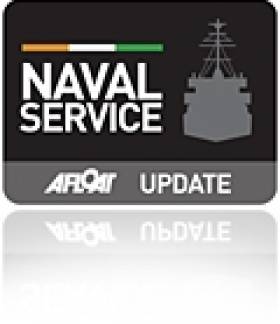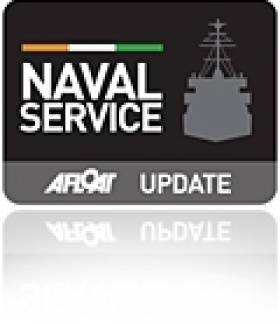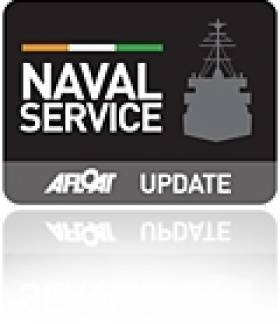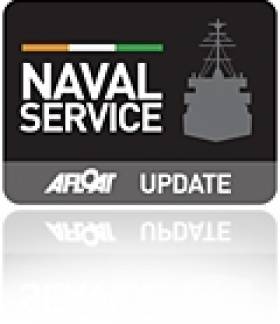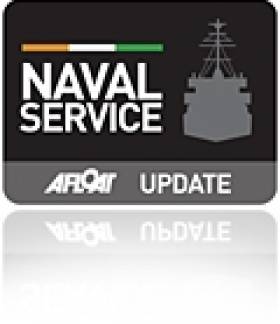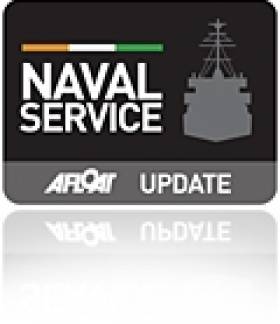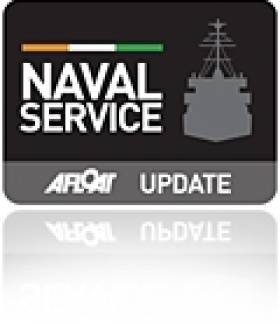Displaying items by tag: Navy
Naval Service Rescues More Migrants
#EithneMedCrisis - In operations that took place in two separate incidents writes The Belfast Telegraph, about 50 miles north-west of the Libyan capital Tripoli, men, women and children were taken off two wooden barges.
The crew of the LE Eithne (P31) took part in the first search and rescue after transferring a group of 593 migrants to HMS Bulwark (L15).
The first rescue started at about 8am Irish time when 330 people were safely taken from a barge and immediately afterwards the crew was tasked to assist with another rescue of 317 migrants on another barge.
The migrants included 544 men, 95 women and eight children, the Naval Service said.
#NewEUmigrantMission - L.É. Eithne has rescued a further 519 migrants yesterday, as part of the coordinated response to the migrant crisis in the Mediterranean which was welcomed by Minister for Defence, Mr. Simon Coveney, T.D.
The Minister commented "L.É. Eithne under the command of her captain, Commander Pearse O'Donnell, and her crew are continuing to undertake a key role in addressing the humanitarian crisis in the Mediterranean. The rescue operation today, involving 519 migrants, is yet another example of the worthwhile efforts being undertaken by our Naval Service."
L.E. Eithne was alerted to three craft in potential distress approximately 50 nautical miles northwest of Tripoli.
The Minister confirmed that "L.É. Eithne has completed the rescue of 104 personnel from the first craft, 363 from a second vessel and 53 from a third vessel. This brings the total migrants rescued so far to 2,136."
The Irish Naval Vessel is providing medical assistance, food, water and dry clothes to those in need and will transfer them safely to port in Italy as soon as possible.
New EU Military Operation
Separately the Foreign Affairs Council adopted a Council Decision yesterday to launch a European Union military operation, EUNAVFOR MED as one element of the EU's comprehensive approach to the Mediterranean crisis.
The EUNAVOR MED mission will undertake systematic efforts to identify capture and dispose of vessels and enabling assets, before they are used by traffickers, thereby contributing to disruption of the business model of human smuggling and trafficking networks in the Southern Central Mediterranean.
Phase one of this mission, which focuses on surveillance and assessment of human smuggling and trafficking networks in the Southern Central Mediterranean, will commence in the coming days. Further phases will be subject to assessment by the European Council, taking into account a UN mandate and the consent of the coastal states concerned.
The Minister concluded that "the work of our Naval Service in the Mediterranean is invaluable. The Naval Service will remain in the Mediterranean undertaking humanitarian search and rescue activity. We do, however, need a comprehensive approach to addressing this ongoing crisis. Today's Council Decision to launch an EU mission is just one part of a bigger strategy. The Taoiseach at the EU Heads of State and Government meeting later this week will give further consideration to the broader migration issue".
#EithneMedRescue – Naval Service 'flagship' LÉ Eithne (P31) successfully located and rescued 367 migrants on a wooden barge yesterday some 50kms north-west of Tripoli, the Libyan capital.
Almost the same number of migrants again on a barge were rescued earlier this month off the North African coast.
According to the Naval Service, conditions during this latest indicdent were choppy with the operation commencing at 7.25 am during a south easterly 1 metre high swell. All migrants were successfully taken on board by 10.09 am. On board the LÉ Eithne were 278 male, 80 female and 9 children where they received medical screening, food and water.
The LÉ Eithne next tasking will be under the direction of the Italian Maritime Rescue Co-Ordination Centre.
A month ago today LÉ Eithne departed Cork Harbour on the 16th of May to assist the Italian Authorities in the humanitarian search and rescue operations in the Mediterranean.
The role of the Irish Naval vessel will be to provide a search and rescue capability and to undertake humanitarian rescue operations at sea in the Mediterranean.
Assistance to persons in distress at sea will be provided in accordance with the applicable provisions of international conventions governing search and rescue situations.
The Naval Service vessel will be deployed in the Mediterranean for a period of up to six months over the summer period, subject to the operational demands and requirements arising in the theatre of operations.
#YeatsFinalJourney – Peter Murtagh of The Irish Times writes of a long forgotten record of the return to Ireland of the remains of WB Yeats.
The records emerged from the Military Archives and is available online to coincide with the 150th anniversary on Saturday of the poet's birth.
The body of the poet, who died in January 1939 and was buried at Roquebrune-Cap-Martin in south-eastern France, was brought by sea from Nice to Galway in September 1948 for reinterring in Drumcliffe Churchyard in Co Sligo. It was transported by the LE Macha, the first overseas deployment of a ship of the Naval Service.
The operation was overseen by the then minister for external affairs, Sean McBride, son of Maud Gonne-McBride, the subject of unrequited, but poetically inspiring, amour from the poet.
The rediscovered record of the repatriation includes just over 30 minutes of film - silent, grainy and mostly black and white footage of the Macha's mission; more than 80 black and white photographs; the ship's log; and five informal letters to the first head of the Naval Service, Captain HJ Jerome, from an officer on board the Macha, Commander Thomas McKenna, who in due course succeeded Capt Jerome to lead the service.
To this has been added a recording of the only surviving member of the crew, former Petty Officer Patrick Campbell, who is now aged 90 but has a clear recollection of the mission.
"When we docked in Nice there was great excitement because it was the first Irish ship [there flying the] tricolour. We did get a good reception," Mr Campbell told a researcher at the Archive after his daughter, Antonette, contacted the Defence Forces earlier this year saying her father had a story to tell.
For much more, The Irish Times reports here.
400 More Med Migrants Plucked by Irish Navy
#EithneMedRescue - LÉ Eithne (P31) the Navy Service flagship writes the Independent.ie, has rescued more than 500 men, women children and infants desperately attempting to cross the Mediterranean this weekend.
Yesterday morning the ship rescued 310 migrants from a barge floating in the Mediterranean 40km north of Libya.
Then at 5pm the LÉ Eithne located and rescued migrants on two inflatable craft -this time with 89 persons on board - some 75 kilometres north of Libya. Conditions at the time were good and the operation took two hours.
There are now 399 rescuees on board the Irish ship who owe their lives to the skilled Irish naval services. They number 280 men, 78 women and 41 children in total and will be transferred to other vessels to bring them safely to shore.
On Friday, the LÉ Eithne rescued another 113 migrants adrift on a rubber inflatable dinghy north of Tripoli. They were all given food and water once they were safely on board and then transported to shore.
The LÉ Eithne has now saved more than 1,000 people since it left Cork three weeks ago on May 16 (as previously reported on Afloat.ie)- sailing to assist the Italian authorities in the ongoing search- and-rescue mission in the southern Mediterranean waters.
For more on the story click here.
#EithneMigrants - Naval Service flagship LÉ Eithne (P31) conducted a second successful rescue operation in the Mediterranean this morning involving 300 migrants according to Minister for Defence, Mr. Simon Coveney, T.D.
The Minister commented "the continued efforts of the LÉ Eithne to make a real contribution to the migrant crisis in the Mediterranean is commendable, this second rescue coming immediately after handing over rescued migrants from yesterday's operation reflects the commitment and professionalism of the Ship's crew.
This latest incident occurred 45 kilometres North of Libya in the early hours of this morning. The migrants were on board a barge that was attempting to cross the South Central Mediterranean. The migrants include men, women and children.
The LÉ Eithne handed over 201 rescuees from yesterday's rescue operation over to HMS Bulwark (L15) the Royal Navy's flagship as previously reported on Afloat.ie.
The second migrant rescue role was received from the Italian Marine Rescue Co-ordination Centre. The LÉ Eithne deployed immediately to assist and arrived on scene at 4 am.
The Minister has confirmed that "All 300 migrants from the barge were successfully taken on board the LÉ Eithne and the ship is currently awaiting further instruction from the Italian Marine Rescue Co-Ordination Centre"
#SixServiceFleet - The deployment of LÉ Eithne (P31) on a humanitarian mission to the Med, the fate of 'Aoife' and delays of newbuild OPV James Joyce, sees the Naval Service fleet reduced to 6 patrol vessels operating within Irish waters, writes Jehan Ashmore.
In recent years the Naval Service had a 8-strong fleet with the inclusion of LÉ Emer (P21) and sister LÉ Aoife (P22), however the former Offshore Patrol Vessel was sold overseas to Nigerian interests in 2013. This year the 'Emer' was transferred to the west African state's navy.
The 'flagship' LÉ Eithne commissioned as a Helicopter Patrol Vessel (HPV) made a transit of the Strait of Gibraltar this Tuesday heading for an Italian base port, yet the issue surrounding the decommissioned Aoife remains unresolved. This followed an Irish Government proposal to 'donate' the OPV to Malta but rebuffed by certain quarters of the island state's military as to her unsuitability in migrant SAR duties.
Afloat.ie has asked the Department of Defence for an update which responded with the same reply as previously reported (see report Aoife's almost full-circle role) in that the 'Department are in discussions with the Maltese authorities in relation to the modalities to be agreed in relation to the transfer of ownership of the decommissioned LÉ Aoife'.
As for the second newbuild Offshore Patrol Vessel (OPV) 90 class, James Joyce, she remains at the Babcock Marine & Technology Shipyard, Appledore in north Devon. As previously reported a month ago the newbuild had 'technical' issues following her first sea-trials that took place in March off Lundy Island in the Bristol Channel.
The Department however added that further trials of the James Joyce have since taken place.
It was also then reported last month that the €54m James Joyce would make her delivery voyage within weeks followed by a commissioning ceremony due this month. Whenever this ceremony takes place James Joyce will officially be designated with the ship's name prefix L.É. that means Long Éireannach or Irish Ship.
Currently the fleet that is in Irish waters comprises of a pair of 'Peacock' class coastal patrol vessels (CPV), three OPV's in the form of the sole remaining 'Emer' (modified Deirdre class) and a pair of 'Roisin' class OPV80s. The final unit is made of one Large Patrol Vessel (LPV) that been an enhanced version of the 'Roisin' class in the form of the 'Beckett' OPV90 class.
The Naval Service fleet of 7-strong patrol vessels are listed below.
HPV L.É. Eithne (P31) flagship (currently on overseas deployment)
CPV L.É. Orla (P41)
CPV L.É. Ciara (P42)
OPV L.É. Aisling (P23)
OPV L.É. Roisin (P51)
OPV L.É. Niamh (P52)
LPV L.É. Beckett (P61)
Each vessel is equipped with state of the art machinery, weapons, communication's and navigation systems.
In addition the Naval Service have on contract with Babcock Marine for a third and final sister of James Joyce which is due for delivery in 2016.
#EithneMedCrisis – It has been confirmed LÉ Eithne (P31) is to depart Cork Harbour this morning on a humanitarian mission to the Mediterranean as previously reported on Afloat.ie following discussions held between Irish and Italian authorities, writes Jehan Ashmore.
The deployment of the 1,800 tonnes 'flagship' is for a period of six months by the Minister of Defence Simon Coveney T.D. was recently given approval by Government. Joining the Minister this morning in the Naval Base Haulbowline, Cork Harbour was An Taoiseach Enda Kenny T.D. who met the crew before the HPV vessel departs for the Mediterranean.
At the ceremony, the Minister stated that "The humanitarian crisis in the Mediterranean is of great concern to Ireland. The quick response by the Irish Government in deciding to despatch a Naval Vessel highlights our commitment to assist with efforts to prevent further tragedy and loss of life at sea."
The Minister further stated that "The despatch of an Irish naval vessel represents a tangible and valuable Irish national contribution to assisting the Italian authorities in the humanitarian search and rescue operation."
A crew of 68 personnel from the Permanent Defence Force and 2 medical staff from the Army Medical Corps will assist Italian authorities in the carrying out of humanitarian search and rescue of refugees subject to the operational demands and requirements.
It is understood this is the first time in almost 60 years that an Naval Service vessel is to be deployed for humanitarian purposes.
The Minister concluded by saying "I wish to commend the Defence Forces on their efficient operational and logistical planning for this deployment. I want to wish each and every crew member of L.É. Eithne, under the command of Commander Pearse O'Donnell, a safe and successful mission. You will be in our thoughts throughout the duration of your tour of duty."
The 31 year-old L.E.Eithne was launched in 1984 as a Helicopter Patrol Vessel (HPV) which used to carry a 'Dauphin' helicopter on the extensive aft- deck. Next to the aft-deck is an adjoining hanger which will further assist in her new role in the rescue of refugees.
Note to the left of the twin funnels (abreast) with the hanger area below is a RIB and associated derrick (click photo from previous report) which was not part of the original ship when completed by Verolme Cork Dockyard. It is understood this RIB that rests on a cradle structure brings to three RIB craft onboard.
As the numbers of fleeing migrant refugees rises from war-torn regions in the Middle East and throughout northern swathes of the African continent, the EU has stepped up its efforts to assist authorities.
Among the nations already involved are the UK which has its 'flagship' HMS Bulwark carrying out rescue of refuges using the amphibious vessels fleet of landing craft.
Government to Deploy L.É. Eithne to Assist in Humanitarian Crisis in the Mediterranean
#EithneMedCrisis - Minister for Defence, Simon Conveney, T.D. has been given approval by the Government today (12 May) for the deployment of a Naval Service vessel to undertake humanitarian search and rescue missions as previously reported on Afloat.ie in the Mediterrranean.
The last Irish built naval service vessel L.E.Éithne (P31) dating from 1984 whose career was also previously reported will have a crew of around 65 personnel of the Permanent Defence Force are to undertake the task. The decision is subject to finalisation of appropriate arrangements with the Italian authorities.
Following the Government Decision the Minister commented "subject to finalisation of arrangements with the Italian authorities, the L.É. Eithne will be despatched to the Mediterranean without any delay. Operational and logistics planning for the deployment have been completed and the 80m vessel which has a range of 7,000nm at 15 knots is ready to deployed. The humanitarian crisis in the Mediterranean is of great concern to Ireland and to our EU partners. I am anxious that we commence search and rescue activities in the Mediterranean as soon as it is feasible to do so".
The Minister went on to say that "discussions are at an advanced stage with the Italian authorities on arrangements covering a number of issues relating to the deployment of the Vessel. I expect that the Ship should depart the Naval Base in Haulbowline on Saturday, subject to confirmation of the proposed arrangements by the relevant Italian authorities".
Ireland will deploy L.É. Eithne to the Mediterranean for a period of up to six months over the summer period, subject to the operational demands and requirements arising in the theatre of operations, to assist the Italian authorities in the humanitarian search and rescue operations.
The Minister highlighted the Government's commitment to continuing Ireland's strong tradition of peacekeeping and stated that "the proposed deployment of an Irish Naval Service vessel to the Mediterranean will bring the number of Defence Forces personnel deployed overseas to approximately 500 Irish personnel."
#EithneMedCrisis - Naval Service HPV LÉ Eithne (P31) writes The Irish Times is to be dispatched to the Mediterranean Sea to participate in an EU search and rescue mission for migrants fleeing north Africa, the Minister for Agriculture, Food and Marine has said.
Simon Coveney told RTÉ radio this Tuesday morning he hoped the LÉ Eithne would be ready to leave for the Mediterranean by (this) Friday, May 8th.
He said the vessel was being prepared in Haulbowline naval base in Cork harbour so that it could "successfully save people and drop them to local ports in the vicinity of the Mediterranean".
Mr Coveney said the Taoiseach was anxious to respond to the crisis in southern Europe by providing " humanitarian and emergency rescue response capacity".
The European Union has been struggling to forge a united response to the migration crisis currently sweeping across the Middle East and north Africa as desperate migrants flee their homes for refuge in Europe.
No decision has yet been made on Ireland's participation in a European pilot resettlement programme for migrants.


























